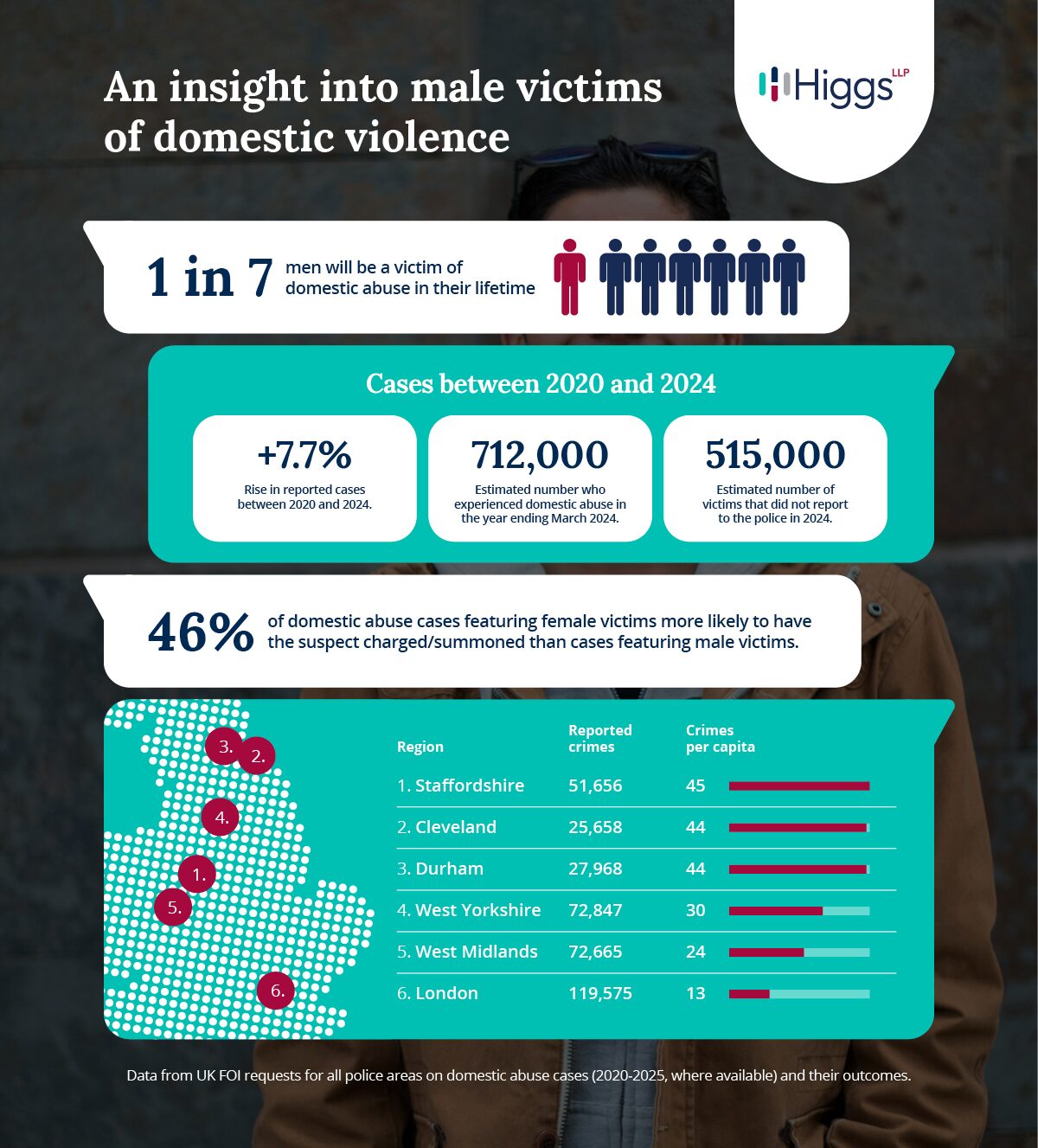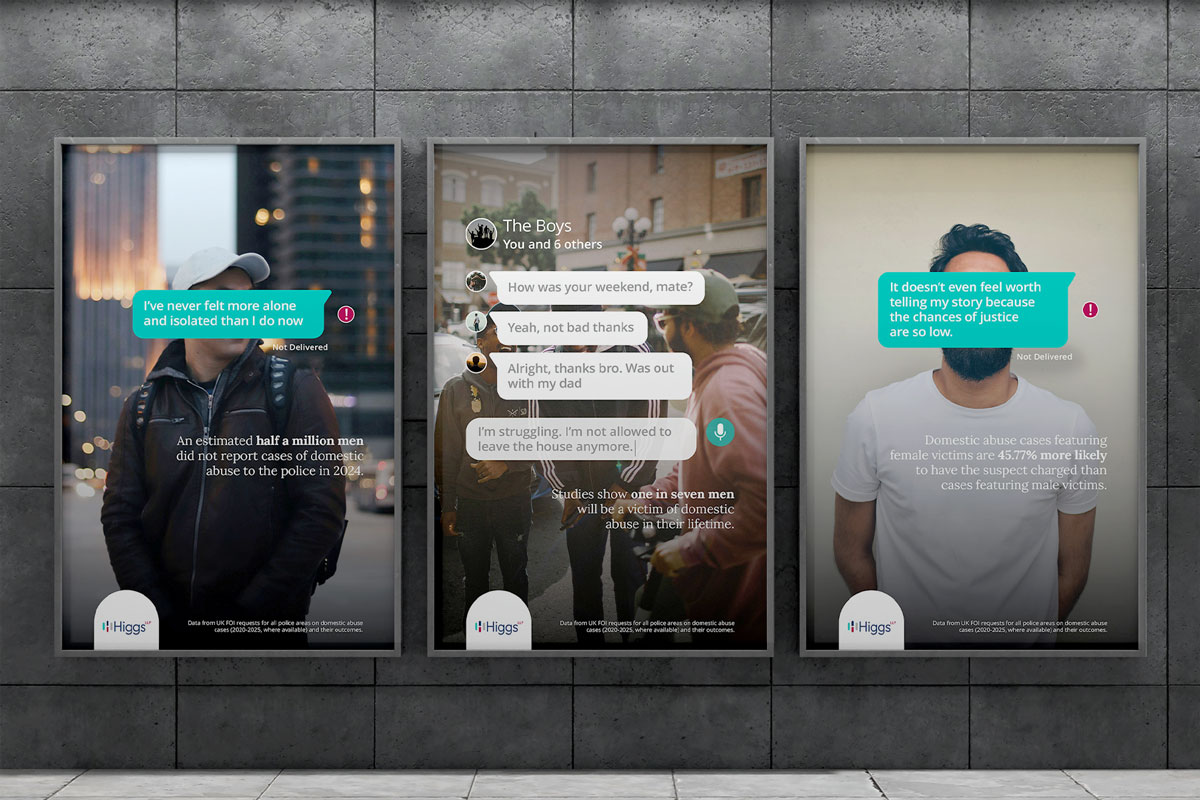Domestic abuse is a widespread and devastating issue affecting people of all genders. While much attention is rightfully given to the epidemic of violence against women, a significant number of men also suffer in silence. Too often, these men are silenced by fear, isolation, and stigma, leaving them unable to seek help when they need it most.
Our campaign, (un)reported, used Freedom of Information (FOI) requests across the UK to gather vital data on domestic abuse cases involving male victims from 2020 to 2025. These findings offer a new perspective on the often-overlooked issue of male victims of domestic violence, challenging conventional narratives and amplifying the voices of men who suffer alone.
We believe that knowledge is power, and it’s time to confront this issue head-on. By sharing these insights, our aim is to raise awareness and spark a broader conversation — one that includes all victims of domestic abuse, regardless of gender.

An estimated half a million men did not report cases of domestic abuse to the police in 2024
Our analysis found that cases of domestic abuse where men are the victims rose by 7.7% between 2020 and 2024, with our trend analysis indicating a YoY average increase of 1.97%, reaching 196,381 cases by 2024.
Worryingly, statistics from The Crime Survey for England and Wales estimated that 712,000 men experienced domestic abuse in the year ending March 2024. This highlights a concerning disparity between police-reported cases and the actual incidence of domestic abuse. Based on this data, we have estimated that over 515,000 victims did not report their experience of domestic violence to the police in 2024.
Where are the worst areas of the UK for domestic abuse against men?
We analysed the total number of domestic abuse crimes involving male victims across different counties and then adjusted the data on a per capita basis. Our findings revealed that Staffordshire has the highest rate of domestic abuse involving male victims in the UK, with 51,656 cases reported between 2020 and 2024. This equates to more than 45 incidents per 1,000 people in the county (45.07).
Following closely, Cleveland emerged as a key area of concern, with 25,658 reported cases of domestic abuse against men over the same period. This translates to 44 incidents per 1,000 people (44.24).
Durham ranked third, with 27,968 cases reported between 2020 and 2024. This equates to 44 cases per 1,000 people (43.91), making it another region of significant concern.

When looking at total case numbers, London’s Metropolitan Police reported the highest overall figure, with 119,575 cases. However, due to its higher population density, the per capita rate was lower, at 13 cases per 1,000 people (13.29). Similarly, West Yorkshire (72,847 cases) and the West Midlands (72,664 cases) showed high numbers, though their per capita rates were 31 cases (30.63) and 25 cases (24.60) per 1,000 people, respectively.
How many male victims of domestic abuse get justice in court?
Our analysis uncovered a deeply troubling and heartbreaking reality. On average, just 6.97% of domestic abuse cases involving male victims result in the perpetrator being charged.
The likelihood of charges or summons varied significantly by region. South Wales had the highest charge rate at 13.59%. However, this still resulted in less than 3,000 of the 20,970 cases resulting in justice for the victim. Cases in Lancashire and Northumbria also saw slightly higher charge rates, with 10.34% and 9.85% respectively.
Conversely, some regions showed alarmingly low charge rates. In the West Midlands, the likelihood of a perpetrator being charged was under 2% (1.93%), while Greater Manchester and Wiltshire also had low charging rates of 2.70% and 4.05%.
As part of this campaign, we also examined the most common outcomes of domestic abuse cases by region. It was only in Avon and Somerset where charges or summons were the most frequent result. Worryingly, in 94.6% of regions, the most common outcome was linked to the victim’s willingness to engage with the legal process. This often involved the victim not supporting police action or withdrawing support for the case.
Karen Gray, domestic abuse lawyer at Higgs LLP, explains this is not unusual for victims of domestic abuse to withdraw support, due to serious issues with the UK’s criminal justice system:

“It’s not uncommon for victims of domestic abuse to withdraw their support for prosecution. A variety of factors can influence this decision, but one of the most significant is delays in the process.
The UK criminal justice system is facing serious shortcomings, exacerbated by budget cuts, which often lead to cases being downgraded or lacking specialist support.
As a result, domestic abuse cases can take months or even years to reach a resolution. This prolonged process forces victims to relive traumatic experiences without closure, while giving perpetrators more time to threaten or intimidate the victim.
Victims often feel isolated and powerless, which can lead them to withdraw their support entirely. It’s heartbreaking to see this happen, and our findings show that it’s all too common. This underscores the urgent need for change. Victims must always feel supported, and delays should never stand in the way of justice.”
Karen Gray
Domestic Abuse Lawyer
How do domestic abuse cases differ between male and female victims?
To better understand how domestic abuse cases differ depending on the gender of the victim, we also analysed the likelihood of perpetrators being charged in male vs. female victim cases.
While women are statistically more likely to experience domestic abuse, affecting around 1 in 4 women, our findings uncovered a significant disparity in how these cases are handled by the justice system. Our data shows that domestic abuse cases where the victim was female were 45.77% more likely to result in the suspect being charged or summoned compared to cases involving male victims. This disparity may discourage men from coming forward, leaving them without the protection and justice they deserve. While there may be multiple factors influencing this disparity, the data raises serious concerns about whether male victims receive equal access to justice.

The stigma around men facing domestic abuse
The ManKind Initiative found that 58.9% of men who call their helpline have never spoken to anyone before about the abuse they are experiencing, and 64% would not have reached out if the helpline were not anonymous.
Given our findings, highlighting the lack of victim support, the extremely low likelihood of perpetrators being charged, and the stigma surrounding male victims of domestic abuse, it is sadly unsurprising that so many men feel their only option is to suffer in silence.
Gray explains, “A damaging stigma surrounds male victims of domestic abuse, rooted in the false idea that seeking help makes them ‘less of a man.’ Many fear that coming forward will lead to ridicule or that they won’t receive the support they need. As a result, men often experience shame, embarrassment, and isolation, preventing them from speaking out. Compounding this issue is the lack of specialist support available for male victims. While there are numerous charities and helplines dedicated to supporting women, many services for men operate on limited hours, often closing on weekends. Meanwhile, women’s helplines, already underfunded, do not have the resources to extend support to men as well.
“Another common misconception is that male victims of domestic abuse are primarily in same-sex relationships, with a male perpetrator. However, this is not the full picture. Women can also be abusers, and the pervasive myth that men are ‘strong enough to handle’ abuse from a woman is a dangerous narrative that further silences victims. Male victims also face coercive control, emotional abuse, and non-physical forms of violence, which may not always be recognised by authorities.”
The importance of seeking help
Breaking the cycle of domestic abuse is essential. Seeking legal advice not only helps victims understand their rights but also ensures they are connected to confidential support services and have access to the resources they need to stay safe.
Gray explains, “I cannot stress enough how vital legal support is in the fight against domestic abuse. Victims don’t need to wait until they are in an emergency to seek help. If there are warning signs, such as controlling behaviour, physical violence, threats, isolation, intimidation, or sexual abuse, it is your right to seek support to ensure your safety. No one should have to suffer in silence. If you or someone you know is experiencing domestic abuse, support is available. Seeking help is not a sign of weakness — it is a step towards safety and justice.”
Depending on the situation, different levels of support are available. Legal professionals specialising in domestic abuse can provide guidance on protective measures, such as Non-Molestation Orders and Occupation Orders, which are crucial for safeguarding victims. These legal protections offer security, empowerment, and a pathway to justice, ensuring victims can move forward without fear.
This information is for guidance purposes only and does not constitute legal advice. We recommend you seek legal advice before acting on any information given.






